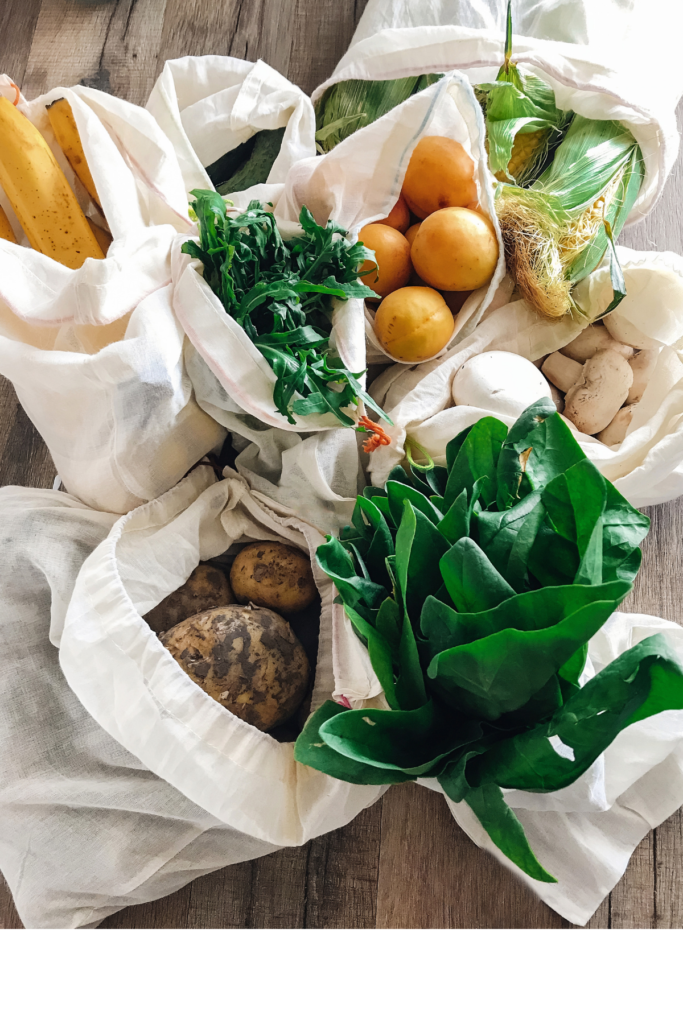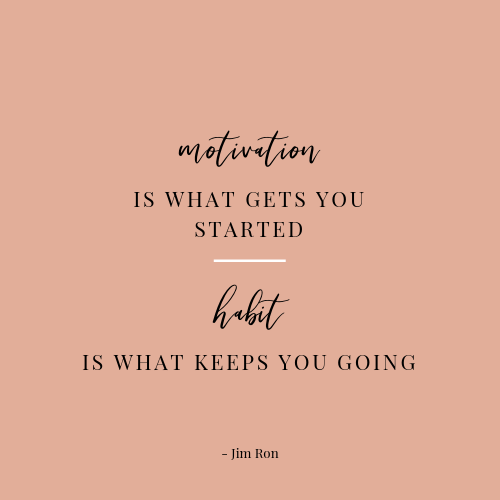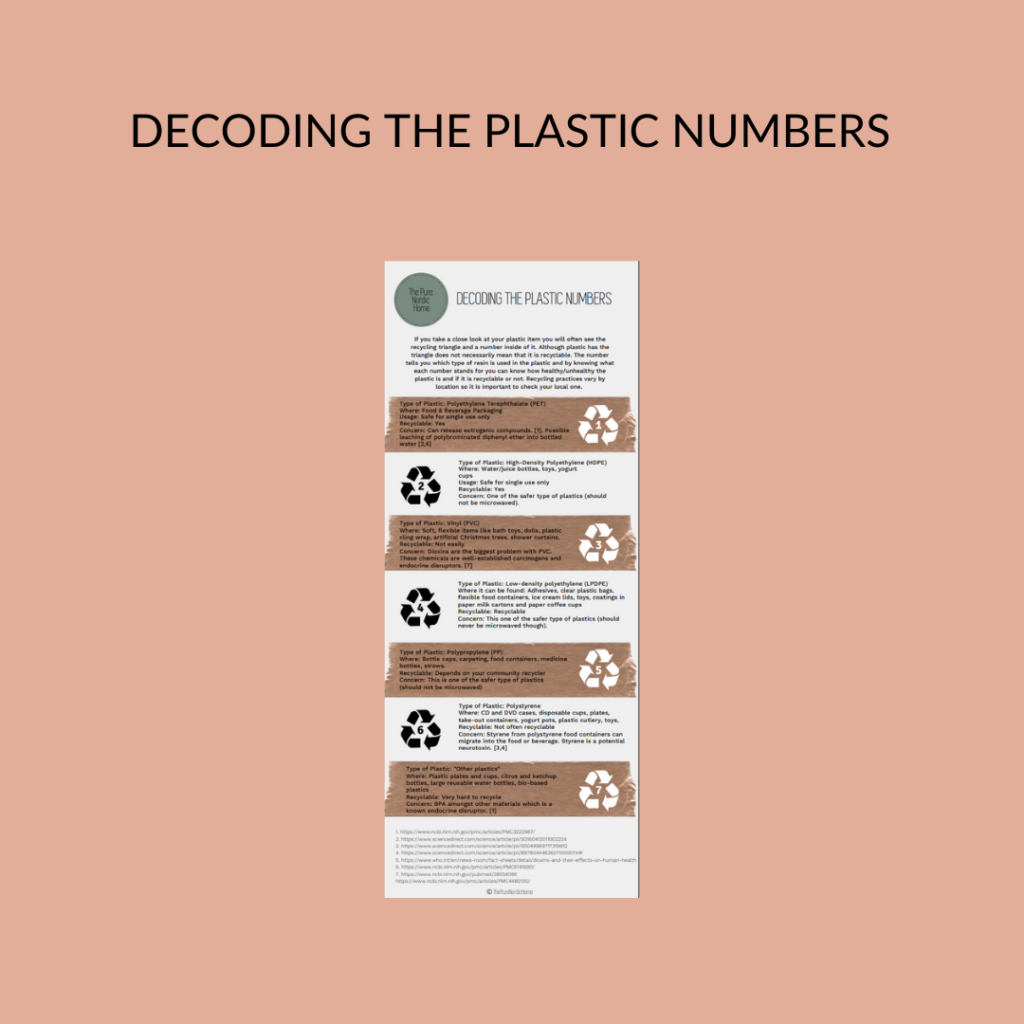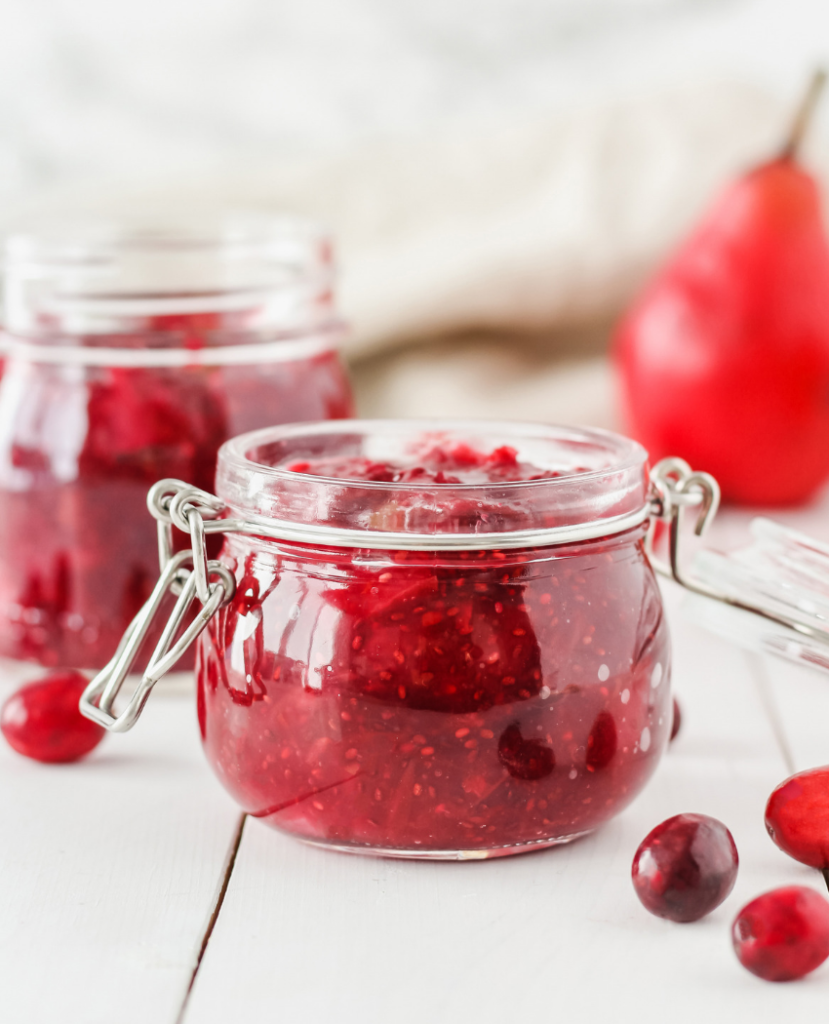There has been so much buzz about plastics in the media lately. Plastics in the ocean, ban on plastics bags, plastic recycling guidelines, ban on single-use plastics like plastic straws, going zero-waste…
When I started reducing plastics and chemicals in our home several years ago, media was not talking about this. People were not discussing this. I had to do quite a lot of digging to find useful information about plastic alternatives.
Because more people are starting on the same journey, companies have begun to offer alternatives.
This post will simplify the buzz about plastics, and give you the knowledge and action steps you need to start or continue on your “kicking out plastics journey.”
It will educate you about why you may want to ditch plastics in your kitchen and give you tips and tricks that will guide you on how to do it.
As a bonus, the tips also support the zero-waste movement.

Your first lesson: Why ditch plastics?
Let’s start with why we are using plastics in the first place. Why is it everywhere?
Lightweight. can be shaped into anything. cheap. transparent. heat resistant. waterproof. durable. great packaging material.
That’s pretty convenient, right?
The more important question is “WHY YOU” want to kick plastics out of your home.
My reason was that I had gotten very intolerant to chemicals (multiple chemical sensitivities). I started reading about chemicals like plastics and decided to start kicking it out from my kitchen.
Our brains are wired in such a way that they need the motivation to change a habit, and if you are on autopilot, you will follow the path of least resistance.

After I had gotten rid of the sensitivities, I found it harder to do healthy changes in my home, even if I had the knowledge.
I had to find a new reason, and even though it’s good for us not to be surrounded by plastics, it is even more important for our children.
That was my new why, along with protecting our dear Mother Earth.
If you want to be successful in reducing plastics in your home, you must find a clear why and to form micro-habits that you frequently do.
It’s not a thing that you do once, and you are done.
Next up are some motivational facts that might help you with understanding why you want to reduce plastics in your home.
Types of plastics and how they can influence health
Several chemicals are added to plastics to achieve specific material properties like to make it softer or more durable.
Most people, especially parents, know BPA (BPS and other similar materials).
These materials are known as endocrine disruptors [1]. That means they can mimic the effect of hormones in the body, especially estrogen.
They can lead to hormone imbalances and can cause weight gain.
In the kitchen and food-related items, Phthalates are chemicals that are added to plastics and vinyl to make them soft and flexible.
PVC (polyvinyl chloride) is a type of plastic that has phthalates added to it.
Phthalates can wreak havoc on your hormones, which are hard enough to balance these days.
Recycle Plastics?
I would always encourage you to reduce plastics in your home. But if you already have it, it’s important to recycle it correctly.
Most plastic items will have recycle codes printed on them (triangles, or “chasing arrows” with a number inside).
Understanding each code will not only make you a recyclable expert. It will help you know the type of plastics you have in your hands and how it can influence your health.
It’s important to know that even if you see the recyclable code on your plastic item, it doesn’t mean the thing is recyclable.
You need to focus on the number inside of the triangle.
It will have numbers from 1-7. The numbers you want to avoid are the ones with numbers 3,6,7.
If you want to get more into details and understand each plastic type better, where to find it, and how it can possibly influence your health, you can download this infographic:

Reducing plastics in your home doesn’t start there
In this section, we will dive into simple tips to reduce plastics in your kitchen.
To be clear, I’m not going to tell you to kick all plastics out of your kitchen today. That would not be good for your wallet and not for our planet.
The journey of reducing plastics in your kitchen/home actually starts outside of the home.
Refuse & Reuse Plastics
Yes, to stop the flow of plastics into your home you need to learn to refuse what you don’t need.
Say no to plastics when it’s being offered to you (especially the single-use ones).
That includes plastic bags, cutlery, coffee cups, napkins, pens, plastic water bottles, receipts, lids, straws, hotel room toiletries (shampoos and soaps), and so much more.
If you say yes to these items, you are using some of the items for a couple of minutes, and then throwing them in the bin, probably without even recycling.
Some of the items will flow into your home in the form of trash.
That means you need to spend your precious time wondering if you can recycle, throw away into your bin, or will end up as clutter.
The hardest part of this step is the social aspect of it. Most of us do care what others think of us and our acts.
You may get some strange looks when you start saying no to things.
It takes a little practice, and you want to be equipped with a small sentence like:
“No thanks, I’m reducing plastics in my kitchen.”
1. Plastics Packaging
Start by choosing items that are sold in non-plastic packagings, like glass, paper, or steel, or even better without packaging.
Bring your reusables (bags, boxes, jars) to the stores.
Many places have bulk bins now in their stores, so that you can fill your reusable container. This is, however not an option for families with allergies.

Buy whole fruits and vegetables and avoid the plastic-wrapped half ones.
It tends to be easier to shop without packaging in farmer’s markets, health food stores, zero-waste stores, and at the butcher.
You can, for example, ask for your meat or fish to be put straight into your container at the butcher.
Some people are starting to return the plastic packaging to the cashier when paying. Stores are starting to get open to that idea and will help you with that, but most of them are not.
If not, it’s probably not such a good idea to leave a mountain of plastic packaging at the poor cashier, who has nothing to do with all this trash.
You may ask what type of containers you should bring to the store.
You can bring everything reusable you can think of, like glass boxes, mason jars, clothing bags, even plastic boxes if you already have them.
2. Plastics in Receipts?
The receipts you get when you pay have a BPA plastic coating in high concentration.
By refusing the receipt, you are both limiting your exposure to BPA, and stopping the flow of trash into your home.
You will also encourage the stores to find new solutions, like offering receipts electronically.
If I want to keep a receipt, I just take a picture of it with my phone.
When traveling or on the go
3. Reusable bottles
Bring reusable bottles for coffee and drinks with you at all times.
I know this one is hard to remember. The other day I was traveling to the US and brought a reusable, stainless steel bottle with me.
Without realizing it, I was sitting in the airport, sipping on my smoothie from a plastic cup, from a plastic straw with my empty reusable bottle in my bag!
If my brain would have been turned on, I could easily have said: “Could I please get my smoothie straight into my bottle?” Would have been no problem, if I would have asked for it.
By using reusable bottles/cups, you are saying no to single-use plastic cups and plastics straws, which is excellent news for our planet and environment.
At the store
4. Grocery Bags
I know how easy it is to grab plastics bags in the store. Bringing reusable grocery bags to the store can be very hard to make as a routine, and you can easily forget to bring them with you.
But at the same time, it is so important! Plastics bags are such a big source of pollution. Did you know that about one trillion plastics bags are used and discarded each year?
Plastics bags are the second most common waste found in the ocean.
If you forget your bag at home, you can also try to ask for a box from the storing room, or like I sometimes do to remind myself to bring it next time, carry the items.
I recommend keeping one in your purse and one in your car (if you have one).
The tricky part is then to remember always to put the reusable bags back to their place when you have finished using them.
At home
5. Water Filter
Use a water filter in your home so you can drink the water rather than buying water in plastics bottles.
They can be expensive, but it is an excellent investment over time.
6. Home Cooked Meals
Opt for home-cooked meals rather than ordering takeaways.
If you choose to order takeaways, you can try to bring your own reusable box (sometimes it is not allowed by restaurants because of policies). It’s also a good idea to support restaurants that have more sustainable, rather than plastic packaging.
7. Food Storage
I kicked plastics boxes out of my kitchen pretty soon in my journey, because I felt it was important not to store our food in plastics. It didn’t mean that I threw them out of home; I simply used them to store something else than food.
When you start buying things in the stores in glass packaging, you will quickly get a good collection of glass jars.
I love my Mason jar collection, and chances are that you will soon.

Glass jars will be very convenient as a healthy and cheap storing solution for all sorts of things. We even use them as glasses.
You can use them in the kitchen and the rest of your home.
Warning, it can be a real pain to remove the stickers with natural methods. But here are a couple of tricks you can try:
– If the adhesive is not extremely aggressive, you can just let some hot water run on the jar for a while and then peel off.
– Take a paper towel and put a little bit of oil in it and rub the sticker.
– Soak your jar in a pot of hot water for a while.
– Take a wooden spatula and scrape the sticker off (it can be labor-intensive).
– You may need to let it sit in hot water again. Then take a sponge and wash with dish soap.
8. Cling Wrap
Conventional cling wraps are usually made from plastics and can be a very convenient food storage solution.
Unfortunately, many wraps are made from hormone disruptive and plastics. That means they can be contaminated from carcinogenic materials.
The wrap is in direct contact with your food so swapping this one out is a good idea.
If you have big chunks of meat that doesn’t fit into a jar or a box, you can wrap them into parchment paper instead.
Beeswax wrap (vegan options also available) is a natural alternative to cling wrap, and you can use it similarly.
We had one for years but didn’t really use it; we used glass boxes instead. Accidentally it ended up in the washing machine, so we don’t have one anymore.

9. Zip-Lock Bags
“But Zip-Lock Bags are so convenient!”
Yes, I know, but at the same time, it is effortless to switch out for a healthier alternative.
Glass jars or boxes, steel containers, or beeswax wraps are great alternatives.
If you have a lot at home, it would be wasteful to throw them away. I would recommend using them for something else than food-storing, and not buy them next time you run out.
10. Cutting boards
Cutting boards are in direct contact with food. When you are using sharp knives, plastic particles from the plastic board can quickly contaminate the food.
There are many varieties of cutting boards available. Wood, stone, and marble are good examples. Some of them even tolerate the dishwashing machine.
Which tip will you implement in your kitchen?






Rosie (GreenRosieLife)
I love that you call it “kicking out plastics journey” as that is so much more approachable than the seemingly impossible term “Zero waste” for people who are only just becoming aware that they need cut back/reduce.
admin
Thanks, I’m all about simplifying whenever I can. It can easily become overwhelming when you learn about all these things. The worst thing is to stress about it since stress is probably going to be worse for health compared to a couple of plastic items in one’s home. I love the one-step-at-a-time approach.
Lucie
I didn’t know about receipts! That’s a new and easy action I can take. I’ve been implementing many of these tips. I still have lots of plastic storage containers that I continue to use, but will slowly replace them with glass containers as needed. All great tips!
admin
I know, they are a tricky one to know about, but at the same time easy to take action on 🙂 Thanks for reading!
Chelsea Duffy
This is such an important topic! Plastics are harming our health and so many people are unaware! Great post!